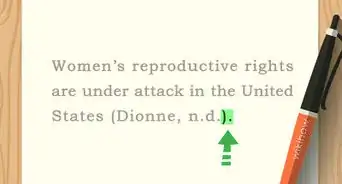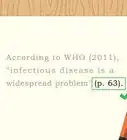This article was co-authored by wikiHow Staff. Our trained team of editors and researchers validate articles for accuracy and comprehensiveness. wikiHow's Content Management Team carefully monitors the work from our editorial staff to ensure that each article is backed by trusted research and meets our high quality standards.
This article has been viewed 41,591 times.
Learn more...
Citations let your readers know exactly where to find the sources you’ve used for an academic paper. If you’re writing a paper for a literature or humanities class, chances are you’ll be using the MLA (Modern Language Association) style guide. Fortunately, citing articles and other sources in MLA style is easy and straightforward. Whether you’re citing a print or electronic source, formatting your citations will be a breeze once you’ve mastered a few details.
Steps
Making an In-Text Citation
-
1Make a parenthetical citation after a quote or reference. To avoid plagiarism, use in-text citations to attribute direct quotes, paraphrased text, or references to other authors’ ideas. Usually, an in-text citation lists the source’s author and the page number you’ve referenced in parentheses. In some cases, you may have to add more detail.[1]
- The aim of an in-text citation is to point the reader to the full entry on your works cited page. When they see the in-text citation (Smith 24), they’ll know to look for the full entry listed on your works cited page under the last name Smith.
-
2Write the author’s name and page number for printed articles. Place the period after the parenthetical citation instead of at the end of your text. Name the article’s author, and include the page number if it’s a printed article or a source that appears in both print and online.[2]
- If there are 2 authors, list them alphabetically, then include the page number: (Jones and Smith 252). If there are 3 or more authors, write the first author then “et al.”: (Jones, et al. 241).
- You only need to include the page number in parentheses if you’ve mentioned the author’s name in your text, like this: “According to Hidalgo, a high-glycemic diet increases the risk of pancreatic disorders (12).”
- Skip the page number if the source doesn’t have one, such as an article on a newspaper website.
Advertisement -
3Include shortened titles if you’ve cited multiple works by 1 author. If your works cited page includes multiple sources by the same author, your in-text citations need to name the specific source. For the sake of brevity, just include the first few words of the title.[3]
- For instance, abbreviate the title “Diabetes Mellitus and Obesity as Risk Factors for Pancreatic Cancer” by G. Eibl to (Eibl, “Diabetes Mellitus” 518).
- If you have 4 sources listed under the author Smith, the in-text citation (Smith 242) doesn’t tell the reader which of the 4 Smith entries you’ve referenced.
Creating a Works Cited Entry for a Print Article
-
1Begin your entry with the author, then add a period. Start with the author’s last name, add a comma, then write their first name. If they have a middle name or initial, place it after their first name, but don’t include a comma after the first name. It should look like this: Thoreau, Henry David.[4]
- For an article with 2 authors, arrange the authors in alphabetical author. Write the first author with their last name first, and the second with their first name first, like this: O’Reilly, Sophie and Noelle Poremski.
- If an article has more than 3 authors, type the name of the first author followed by “et al.”
-
2Write the article’s title in quotation marks. If the article has a subtitle, include it. Add a period after the full title, and be sure to place the period before the final quotation mark.[5]
- So far, an entry would look like this: Lorensen, Jutta. “Between Image and Word, Color, and Time: Jacob Lawrence’s The Migration Series.”
- Note that The Migration Series is a set of paintings. Books, periodical titles, works of visual art, movies, TV shows, music albums, and websites almost always need to be italicized.
-
3Add the magazine, newspaper, or journal title in italics. The MLA handbook refers to magazines, newspapers, journals, and anthologies as “containers.” These are the larger wholes that contain smaller parts, such as articles, essays, and poems. Type the container’s title in italics, place it after the article’s title, then add a comma.[6]
- At this point, your entry should read: Lorensen, Jutta. “Between Image and Word, Color, and Time: Jacob Lawrence’s The Migration Series.” African American Review,
-
4Specify the volume, issue, and date. If you’re citing a magazine or newspaper, include the day, month, and year of publication, then add a comma. For academic journals, include the volume, issue, and year of publication. Use the abbreviations vol. for volume and no. for issue, and separate them with commas.[7]
- An academic journal citation should read: Lorensen, Jutta. “Between Image and Word, Color, and Time: Jacob Lawrence’s The Migration Series.” African American Review, vol. 40, no. 3, 2006,
- When including the full publication date, always abbreviate the month: Buchman, Dana. “A Special Education.” Good Housekeeping, Mar. 2006,
- For newspapers like the New York Times or the Washington Post, there’s no need to include the newspaper’s city. However, include the city in brackets for lesser-known or local newspapers: Gome, Alexandra. “A new year-round watering schedule for Foxboro.” Sun Chronicle [Attleboro, MA], 27 Sept. 2018,
-
5Finish the entry with the page numbers. If the article takes up multiple pages, write “pp.” followed by the page range, and end the entry with a period. Place a hyphen with no spaces between the first and last page numbers. If you’re citing a newspaper, be sure to list the page number exactly as it appears on the printed copy.[8]
- A finished academic citation should read: Jacob Lawrence’s The Migration Series.” African American Review, vol. 40, no. 3, 2006, pp. 571-86.
- A magazine or newspaper citation should look like this: Brubaker, Bill. “New Health Center Targets County's Uninsured Patient.” Washington Post, 24 May 2007, p. LZ01.
Citing an Online Source
-
1Start by formatting the entry as you would a print publication. For an article that appears in both print and online, include the page number. If there’s no page number, skip it.[9]
- You’ll include additional information for online sources, but start with this format: Author. “Title of the article.” Title of the Periodical, Date, Page.
-
2Write the online database in italics, if you used one. Examples of online databases include JSTOR, ScienceDirect, and Wiley Online Library. The MLA handbook calls these “second containers” and recommends listing them in a works cited entry. If you used one, note the online database after the page range, type it in italics, and add a comma.[10]
- Here’s where the online database goes: Hidalgo, Manuel, et al. “Addressing the challenges of pancreatic cancer: Future directions for improving outcomes.” Pancreatology, vol. 15, no. 1, 2015, pp. 8-18. Science Direct,
-
3Include a DOI or URL, followed by a period. If a DOI (digital object identifier) is provided, cite that instead of a URL, as a DOI is more stable. For most electronic scholarly articles, you should see a DOI listed in the publication record next to the publication volume and issue.[11]
- Add a period after listing the DOI or URL: Hidalgo, Manuel, et al. “Addressing the challenges of pancreatic cancer: Future directions for improving outcomes.” Pancreatology, vol. 15, no. 1, 2015, pp. 8-18. Science Direct, doi: 10.1016/j.pan.2014.10.001.
- If you have to use a URL, don’t include the https: Hidalgo, Manuel, et al. “Addressing the challenges of pancreatic cancer: Future directions for improving outcomes.” Pancreatology, vol. 15, no. 1, 2015, pp. 8-18. Science Direct, www.sciencedirect.com/science/article/pii/S1424390314009971.
-
4Finish the entry with a date of access. Including a date of access isn’t required, but the MLA strongly recommends it, especially if you cite a URL or a page that is subject to change. Check your web history to find the exact date you accessed the source. List the full date, remember to abbreviate month, and finish the entry with a period.[12]
- A finished entry looks like this: Hidalgo, Manuel, et al. “Addressing the Challenges of Pancreatic Cancer: Future Directions for Improving Outcomes.” Pancreatology, vol. 15, no. 1, 2015, pp. 8-18. Science Direct, www.sciencedirect.com/science/article/pii/S1424390314009971. Accessed 29 Sept. 2018.
Community Q&A
-
QuestionWhat if there is no author name for in-text citations?
 LibArtsPremed18Top AnswererIn that case, if it is web source, you can put the article title in place of the author name. If it is a book, you can put the book title.
LibArtsPremed18Top AnswererIn that case, if it is web source, you can put the article title in place of the author name. If it is a book, you can put the book title. -
QuestionHow would I make an in-text citation for an online source?
 TorpiTop AnswererThat depends. If there is an author and a publication date, use those as described above. If there is no author given, cite the title of the article "in quotes" instead. If there is no date, just cite the author. If all you have is the title, just cite that. If your online source has page numbers then refer to those, but if not, then you don't have to worry about it.
TorpiTop AnswererThat depends. If there is an author and a publication date, use those as described above. If there is no author given, cite the title of the article "in quotes" instead. If there is no date, just cite the author. If all you have is the title, just cite that. If your online source has page numbers then refer to those, but if not, then you don't have to worry about it. -
QuestionWhat if the quote doesn't have a page number and is an online article, then how do you quote it?
 TorpiTop AnswererIf the source you're using does not have pages, you can simply leave out the page number. Just make it clear in your bibliography that it is an online source.
TorpiTop AnswererIf the source you're using does not have pages, you can simply leave out the page number. Just make it clear in your bibliography that it is an online source.
References
- ↑ https://owl.purdue.edu/owl/research_and_citation/mla_style/mla_formatting_and_style_guide/mla_in_text_citations_the_basics.html
- ↑ https://owl.purdue.edu/owl/research_and_citation/mla_style/mla_formatting_and_style_guide/mla_in_text_citations_the_basics.html
- ↑ https://owl.purdue.edu/owl/research_and_citation/mla_style/mla_formatting_and_style_guide/mla_in_text_citations_the_basics.html
- ↑ https://owl.purdue.edu/owl/research_and_citation/mla_style/mla_formatting_and_style_guide/mla_formatting_and_style_guide.html
- ↑ https://owl.purdue.edu/owl/research_and_citation/mla_style/mla_formatting_and_style_guide/mla_formatting_and_style_guide.html
- ↑ https://owl.purdue.edu/owl/research_and_citation/mla_style/mla_formatting_and_style_guide/mla_works_cited_periodicals.html
- ↑ https://owl.purdue.edu/owl/research_and_citation/mla_style/mla_formatting_and_style_guide/mla_works_cited_periodicals.html
- ↑ https://owl.purdue.edu/owl/research_and_citation/mla_style/mla_formatting_and_style_guide/mla_works_cited_periodicals.html
- ↑ https://owl.purdue.edu/owl/research_and_citation/mla_style/mla_formatting_and_style_guide/mla_works_cited_electronic_sources.html
- ↑ https://owl.purdue.edu/owl/research_and_citation/mla_style/mla_formatting_and_style_guide/mla_formatting_and_style_guide.html
- ↑ https://owl.purdue.edu/owl/research_and_citation/mla_style/mla_formatting_and_style_guide/mla_works_cited_electronic_sources.html
- ↑ https://owl.purdue.edu/owl/research_and_citation/mla_style/mla_formatting_and_style_guide/mla_works_cited_electronic_sources.html
- ↑ https://owl.purdue.edu/owl/research_and_citation/mla_style/mla_formatting_and_style_guide/mla_formatting_and_style_guide.html
- ↑ https://owl.purdue.edu/owl/research_and_citation/mla_style/mla_formatting_and_style_guide/mla_formatting_and_style_guide.html

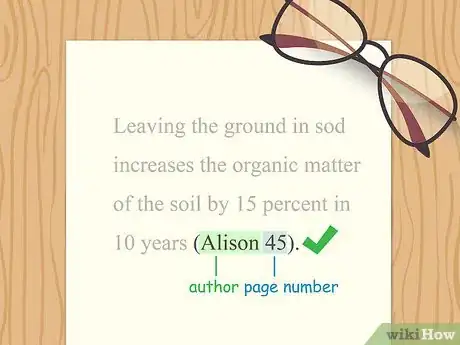
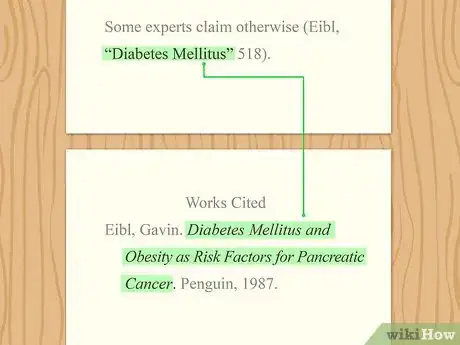
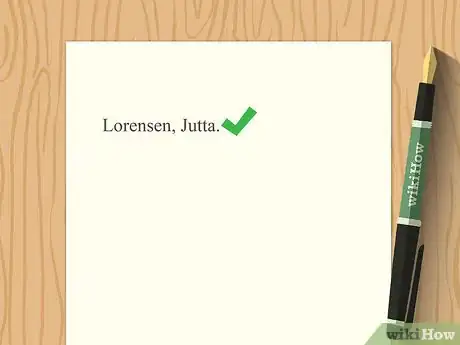




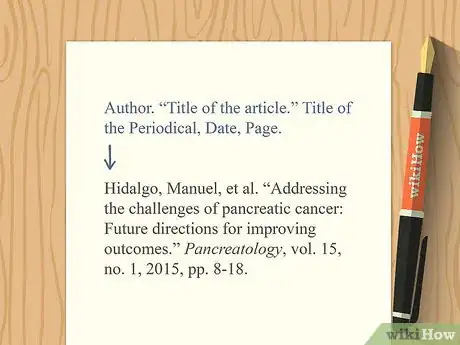

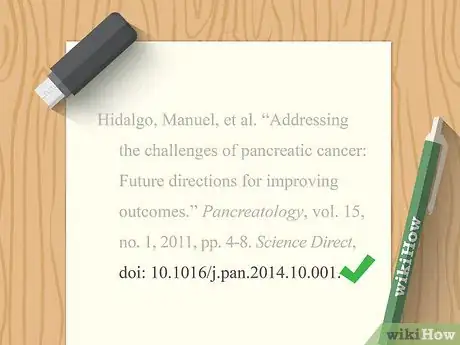
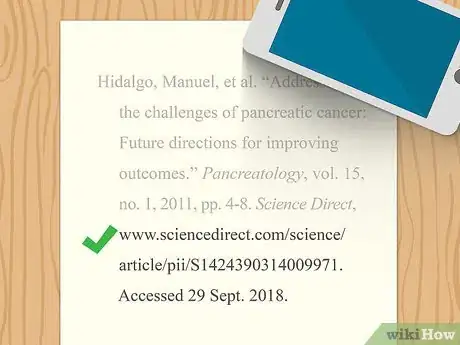




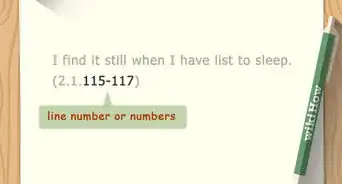

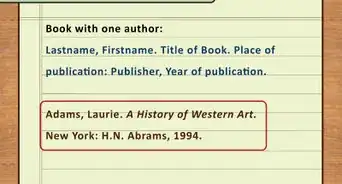
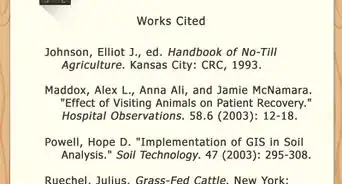
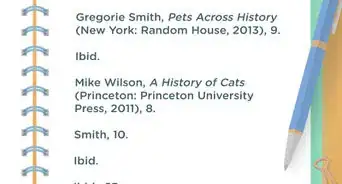

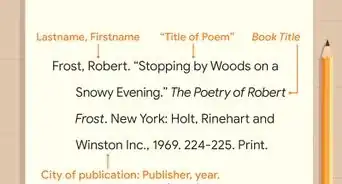
-Step-18.webp)
